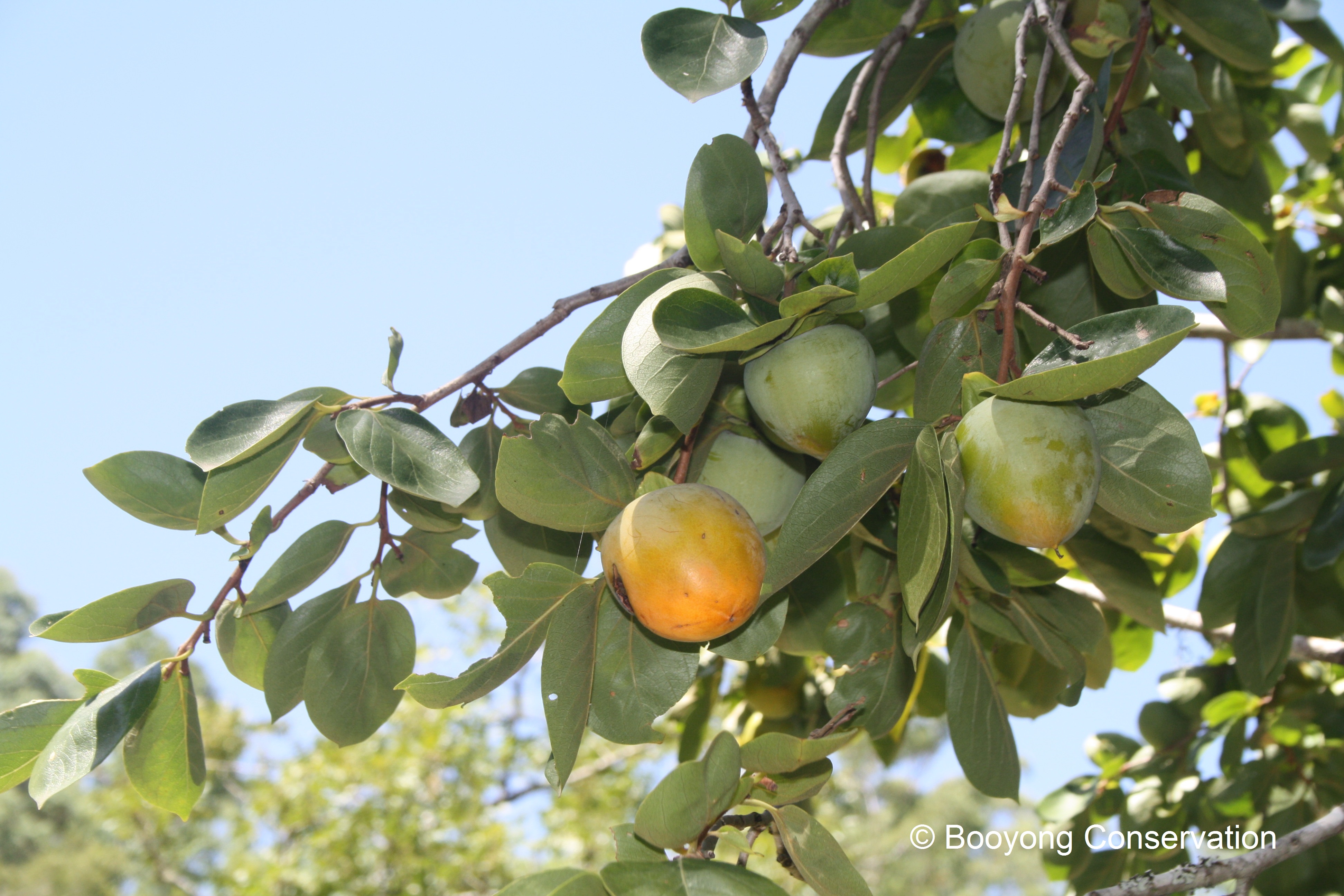 One of our favourite trees in the Orchard is the established persimmon tree – such a bonus as they take many years to establish and bear fruit. It is a very hardy tree that is self-fruiting and appears well suited to the conditions at Booyong.
One of our favourite trees in the Orchard is the established persimmon tree – such a bonus as they take many years to establish and bear fruit. It is a very hardy tree that is self-fruiting and appears well suited to the conditions at Booyong.
Last year we were delighted when the tree was covered in lovely green fruits and so excited to try our first persimmons. We awoke the next morning to discover the tree ripped bear, there was one left! The birds beat us to it; they love them, as do flying foxes.
 To avoid this happening again, we netted the tree this year and have rewarded with abundant fruits. Sadly we used black netting and discovered a native bird that had been caught whilst trying to get to them. Next year we will look at a frame to cover the tree and use white netting to avoid this occurring again.
To avoid this happening again, we netted the tree this year and have rewarded with abundant fruits. Sadly we used black netting and discovered a native bird that had been caught whilst trying to get to them. Next year we will look at a frame to cover the tree and use white netting to avoid this occurring again.
We are uncertain of this particular persimmon tree, but understand it to be the Asian variety with the scientific name to be Diospyros kaki, which means ‘food of the gods’. The fruit is lovely and round, develops a rich orange colour when ripe and is soft and mushy to eat. In summer the tree is covered in soft lush green leaves.
 Persimmons enjoy moderate winters and mild summers, in a sunny position
Persimmons enjoy moderate winters and mild summers, in a sunny position  protected from wind and in slightly acidic soil and do best with a pH of 6.5 to 7.5. They can be grown from seeds, cuttings, suckers of grafts and grow 6 metres at maturity and only require watering when there is little rainfall or in periods of drought.
protected from wind and in slightly acidic soil and do best with a pH of 6.5 to 7.5. They can be grown from seeds, cuttings, suckers of grafts and grow 6 metres at maturity and only require watering when there is little rainfall or in periods of drought.
The best time to plant them is in winter to give them time to establish before the summer months and they don’t like wet feet similar to many other fruit trees and when mulching keep it away from the trunk to avoid collar rot. Aged chicken manure placed into a deep hole is beneficial on planting due to their deep taproots. They don’t require fertilizer but can be fed in late winter or early spring with manure and blood and bone.
The persimmon tree should be lightly pruned to keep its shape and it doesn’t hurt to thin brittle branches that are not strong enough to hold heavy fruit. Flowers buds form on the ends of current season’s growth.
Persimmon trees will compete for nutrients with companion plants, but those that tolerate shade and poor soil will grow near them ( gooseberry, chives and beans ).
We have recently also identified that their are two persimmon trees at the back of the cabin as well, so we will have an abundant supply. They are a stunning red in autumn. 
Interestingly, the wood of the persimmon tree has been used to make golf club heads, flooring and billiard cues.
 When harvesting its best to cut the fruit from the tree. Unripe persimmons are quite astringent due to the soluble tannin in the flesh, however when ripe and of good full orange or deep in colour the astringency will disappear. When they are soft and jelly like with the skin just starting to split, the calyx (green bit at the top) is easy to remove and they can be cut open and the flesh eaten with a spoon. They go well in salad and with cheese love them. We’ve harvested them when we visited last (possibly a little early) and placed them next to ripening bananas on the bench to move the ripening along.
When harvesting its best to cut the fruit from the tree. Unripe persimmons are quite astringent due to the soluble tannin in the flesh, however when ripe and of good full orange or deep in colour the astringency will disappear. When they are soft and jelly like with the skin just starting to split, the calyx (green bit at the top) is easy to remove and they can be cut open and the flesh eaten with a spoon. They go well in salad and with cheese love them. We’ve harvested them when we visited last (possibly a little early) and placed them next to ripening bananas on the bench to move the ripening along.
They can be enjoyed with cream, lemon juice or a little sugar and flesh can be added to salads or blended with ice-cream or yoghurt. Let some get really ripe and freeze whole, they are delicious frozen as they become like a sorbet. Cut in half and eatThey can also be made into jam or marmalade and added to cakes or muffins. They are a good source of vitamin C and A and low in calories and can be eaten dried.

You must be logged in to post a comment.